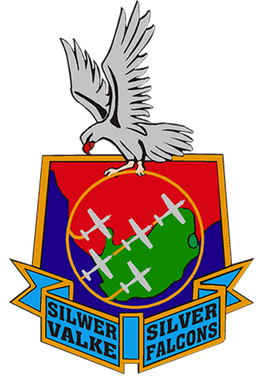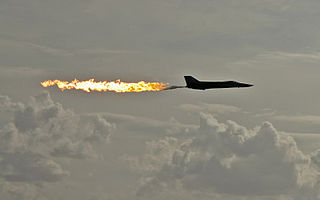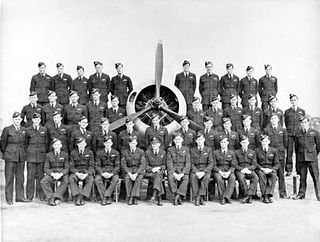
Aerobatics is the practice of flying maneuvers involving aircraft attitudes that are not used in conventional passenger-carrying flights. The term is a portmanteau of "aerial" and "acrobatics". Aerobatics are performed in aeroplanes and gliders for training, recreation, entertainment, and sport. Additionally, some helicopters, such as the MBB Bo 105, are capable of limited aerobatic manoeuvres. An example of a fully aerobatic helicopter, capable of performing loops and rolls, is the Westland Lynx.

The Aermacchi or Macchi MB-326 is a light military jet trainer designed in Italy. Originally conceived as a two-seat trainer, there have also been single and two-seat light attack versions produced. It is one of the most commercially successful aircraft of its type, being bought by more than 10 countries and produced under licence in Australia, Brazil and South Africa. It set many category records, including an altitude record of 56,807 ft on 18 March 1966. More than 800 MB-326s were constructed between 1961–1975.

Surya Kiran is an aerobatics demonstration team of the Indian Air Force. The Surya Kiran Aerobatic Team (SKAT) was formed in 1996 and are a part of the 52nd Squadron of the IAF. The team has since performed numerous demonstrations usually with nine aircraft. The squadron was composed of the HAL HJT-16 Kiran Mk.2 military trainer aircraft till 2011 and were based at the Bidar Air Force Station in Karnataka. The team was suspended in February 2011 and was re-established with Hawk Mk-132 aircraft in 2017.

A trainer is a class of aircraft designed specifically to facilitate flight training of pilots and aircrews. The use of a dedicated trainer aircraft with additional safety features—such as tandem flight controls, forgiving flight characteristics and a simplified cockpit arrangement—allows pilots-in-training to safely advance their skills in a more forgiving aircraft.

The Pilatus PC-21 is a turboprop-powered advanced trainer with a stepped tandem cockpit. It is manufactured by Pilatus Aircraft of Switzerland.

The Patrouille Suisse is an aerobatic team of the Swiss Air Force. The team flies six Northrop F-5E Tiger II fighter/bomber jets.

Warbirds over Wanaka is a biennial air show in Wānaka, held on the Easter weekend of even-numbered years since 1988. It is held at Wānaka Airport, 10 km south-east of Wānaka, in the southern South Island of New Zealand. Initially conceived by New Zealand live deer recovery pioneer, Sir Tim Wallis, as a show for him to display his collection of World War II aircraft, the event has grown into a major institution. Roads are closed and traffic is detoured around the area during the weekend. Hotels, motels and backpackers around Wānaka are usually booked well in advance. Accommodation is impossible to find if one does not have a booking.

RAAF Base East Sale is a Royal Australian Air Force (RAAF) military air base and training school, located in Sale, Victoria, Australia. The base is one of the main training establishments of the RAAF, including where Australian Air Force Cadets from 4 Wing (Victoria) have their biannual General Service Training as well as being home to No. 409 Squadron Australian Air Force Cadets. It is home to The Roulettes aerobatic team. It is also now the home of the RAAF's Officers' Training School (OTS) following its relocation from Point Cook Base. East Sale was upgraded to house the new OTS, which had its first intake of students in January 2008. The base houses approximately 700 air force personnel.

The Silver Falcons is the aerobatic display team of the South African Air Force. Based at Air Force Base Langebaanweg near Cape Town, the Silver Falcons fly the Pilatus PC-7 Mk II, the basic trainer of the SA Air Force in a 5-ship routine. The main purpose of the Silver Falcons is to enhance the image of the South African Air Force, encourage recruitment and instill national pride through public display.

The Australian International Airshow, also called the Avalon Airshow, is a large air show held biennially at Avalon Airport, between Melbourne and Geelong in Victoria.

No. 2 Flying Training School is the main flying training school of the Royal Australian Air Force (RAAF). Formed under its present name in 1969, it is located at RAAF Base Pearce, Western Australia. The unit operates a fleet of Pilatus PC-21 turboprop trainers. No. 2 FTS traces its origins to the post-war re-establishment of the Air Force's original cadet training unit, No. 1 Flying Training School, at RAAF Point Cook, Victoria, in 1947. Following reorganisation of aircrew training in 1951–52, No. 1 FTS was renamed No. 1 Applied Flying Training School, and began specialising in advanced flight instruction on CAC Wirraways. It relocated to RAAF Base Pearce in 1958, where it converted to De Havilland Vampire jet trainers. In January 1969, the school was reformed as No. 2 FTS, having the previous year begun replacing the Vampires with Macchi MB-326Hs. The Macchis were themselves replaced by the PC-9 beginning in 1989.

Air Force Training Group is the Royal Australian Air Force (RAAF) group responsible for training personnel. It is headquartered at RAAF Williams, Victoria. The group was established as Training Command in 1953. It formed part of Support Command between from 1959 to 1990, when it was re-established as Training Command. In July 2006, Training Command was re-formed as Air Force Training Group under Air Command. Air Force Training Group consists of a headquarters and two Academies: Air Academy and Ground Academy.

Central Flying School (CFS) is a Royal Australian Air Force (RAAF) training unit, located at RAAF Base East Sale, Victoria. It operates the Pilatus PC-21 turboprop trainer. The school is responsible for training flight instructors, setting flying standards, and auditing flying practices. It is also home to the "Roulettes" aerobatic team. CFS was the first military aviation unit to be formed in Australia, in 1913, when its role was to provide basic flying training. Its current form dates from World War II, when it was re-established to train flying instructors for the Empire Air Training Scheme (EATS).

The Silver Swallows is the name of Irish Air Corps Aerobatic Team. Active from 1986 to 1998 and reformed in 2022. The team was originally equipped with four Fouga CM170 Magister jet trainers, and was drawn from the Light Strike Squadron of the Irish Air Corps based at Casement Aerodrome, Baldonnel near Dublin. It now uses the Pilatus PC-9M The name Silver Swallows was derived from the colour of the aircraft, and the 'V'-shaped tail of the Magister aircraft the team flew. Throughout its history the team was operated on a part-time basis, with the display duties of the team being secondary to the primary roles of the Light Strike Squadron.

The Temora Aviation Museum is an Australian aviation museum located in Temora, New South Wales. The Museum was established in late 1999, based on the collection of warbird aircraft owned by David Lowy. Lowy remains the President and Founder of the Museum, which is overseen by a five-member Governing Committee.

No. 5 Service Flying Training School was a Royal Australian Air Force (RAAF) flight training unit that operated during World War II. It was one of eight Service Flying Training Schools established by the RAAF to provide intermediate and advanced flying instruction to new pilots as part of Australia's contribution to the Empire Air Training Scheme. No. 5 SFTS was formed at RAAF Station Uranquinty, New South Wales, in October 1941, and disbanded in February 1946. Its staff and equipment were employed to re-establish No. 1 Flying Training School, which transferred to RAAF Station Point Cook, Victoria, the following year. Care and Maintenance Unit Uranquinty was also formed from No. 5 SFTS's facilities, to look after surplus aircraft at the base prior to their disposal, and disbanded in December 1948.
The Tentera Udara Diraja Brunei (TUDB) Alap-Alap Formation is the official aerobatic display team of the Royal Brunei Air Force (RBAirF). The Alap-Alap Formation display team was formed on 7 February 2011.

The Jupiter Aerobatic Team is the current Indonesian Air Force aerobatic display team flying with six KT-1B Wongbee aircraft painted in red and white. The team is drawn from the Skadik 102, Adisucipto International Airport, Yogyakarta. The Jupiter team aircraft are equipped with white smoke generators. The pilots of the "Jupiter Aerobatic Team (JAT)" are all instructors. The team is named "JUPITER" after the call-sign of Indonesian Air Force instructors.

Blue Phoenix are the first ever formed Royal Thai Air Force Aerobatic Team, which fly five blue, white and red painted Pilatus PC-9 aircraft, all fitted with white smoke generators. The team is a part of Flying Training School RTAF Squadron based at Nakhon Pathom's Kamphaeng Saen Air Force Base, and so the pilots are instructors from the same squadron. Blue Phoenix inheriting the aerobatic flying spirit from their former very own aerobatic team of the RTAF Flying School called “Sean Mueang” that was disbanded several decades ago.

The Black Falcons is the aerobatic display team of the Royal New Zealand Air Force.





















